Understanding Lovebirds: Care, Traits, and Relationships


Intro
Lovebirds are not just another feathered friend; they represent a unique charm and a delightful vivacity that many pet bird enthusiasts savor. Originating from the warm climates of Africa, these small parrots are often perceived as bundles of affection, known for their playful antics and strong social bonds. Their colors are vibrant, their personalities engaging, and they are irresistibly captivating.
Before you decide to bring a lovebird into your home, it’s essential to dive deeper into their world. Understanding their origins gives you a glimpse into their social behaviors and care requirements. These birds thrive on interaction and companionship, making them an excellent addition to households willing to invest time and love.
Over the course of this article, we will explore several crucial aspects of lovebird care, including daily routines, cage setup, behavioral insights, and more. Each section aims to provide you with a comprehensive understanding that will allow you to nurture a healthy and fulfilling environment for your new companion.
Let's spread our wings and soar into the fascinating realm of lovebirds.
Preface to Lovebirds
Lovebirds are not merely pet birds; they embody a vibrant essence that captivates bird enthusiasts around the globe. As a foundation for this article, the introduction to lovebirds sets the stage for both current and aspiring owners, illuminating the diverse characteristics that make these charming creatures unique companions. With their lively disposition and affectionate nature, understanding lovebirds becomes essential for anyone considering bringing one into their home.
The significance of this section lies in its comprehensive overview, serving as a springboard into deeper exploration of lovebirds' needs and behaviors. The discussion will unravel their social instincts, resilience, and playful antics, all of which underscore the emotional commitment required from owners. Engaging with this topic clears the air around common misconceptions and lays the groundwork for successful ownership.
Regardless of whether one is a novice or a seasoned bird parent, the insights gained here will facilitate better care and enhance the relationships between owners and their feathered friends.
Defining Lovebirds
Lovebirds belong to the genus Agapornis, a group of small, colorful parrots noted for their strong pair bonds. Unlike many other birds, lovebirds thrive on social interactions, often deriving their name from the deep affection they show to their mates. In essence, they are social creatures, requiring companionship for overall well-being—either from another lovebird or their human counterparts. Each species boasts distinct coloration and temperament, but what binds them together is their intrinsic need for connection and companionship.
Historical Context
The rich history of lovebirds traces back to their native habitats in Africa, particularly in regions like Madagascar and the Zambezi River valley. Over the years, these birds have captivated humans, leading to their domestication as cherished pets. The first lovebirds appeared in aviculture during the 19th century, and their popularity has continued to rise.
Understanding their journey reveals insights not only about their beauty but also about their behavioral nuances. In the wild, lovebirds exhibit complex social structures and communicate with various vocal sounds, ranging from soft chirps to loud squawks, often signaling their moods or status within their flocks. As they made their way into homes worldwide, their ability to bond with humans became a focal point, making them a preferred choice for those seeking an interactive and affectionate pet.
This historical context enriches our understanding of lovebirds as tactical and emotional beings, setting the stage for further discussions on their needs and characteristics, vital as we move forward in nurturing a fulfilling relationship with these delightful birds.
Species and Varieties of Lovebirds
The exploration of species and varieties of lovebirds is essential in understanding their uniqueness and care requirements. Each type has its own distinct characteristics, behaviors, and needs, making it crucial for pet owners to familiarize themselves with these aspects. Knowing which species fits best with one's lifestyle can enhance the bonding experience and ensure a loving environment for the birds. The variety of lovebirds available in the pet market caters to different preferences, whether one is inclined towards vibrant colors or engaging personalities.
Common Varieties
Peach-Faced Lovebirds
Peach-Faced Lovebirds are perhaps the most recognized among the lovebird species, charming many with their vivid hues and playful demeanor. They are easily identifiable by their peach-colored faces that contrast with their vibrant green bodies. These birds are social and thrive on interaction, making them an excellent choice for first-time bird owners. The key characteristic that sets them apart is their affectionate nature, often forming strong bonds with their owners.
One unique feature of Peach-Faced Lovebirds is their vocalization. They can be quite chatty, bringing life to any room they inhabit. This sociability is an advantage as it encourages communication and interaction within the household. However, a downside could be their demand for attention and social stimulation; neglect can lead to behavioral issues. As pets, they often engage in delightful antics, showcasing both their playful spirit and intelligence.
Fischer’s Lovebirds
Fischer’s Lovebirds are known for their exuberant personalities. They display a delightful array of colors, predominantly green, yellow, and orange, which add a splash of vibrancy to any home. What makes Fischer’s keenly captivating is their playful inquisitiveness; they enjoy exploring their surroundings, pushing boundaries in a safe manner. This constant engagement can be beneficial for those looking for lively companions that bring joy.
Their social nature is another reason why they are a popular choice for avian enthusiasts. Fischer’s Lovebirds tend to bond well with their human caregivers and other birds. A unique feature of their behavior is their penchant for mimicry; they might surprise you by imitating sounds from their environment. On the downside, they can be very territorial, especially when paired with another lovebird. They may need careful introduction to minimize aggressive tendencies.
Masked Lovebirds
Masked Lovebirds bring a subtle, yet distinct appearance to the table, with their elegant masks that differentiate them from other lovebird varieties. The striking contrast of their green bodies against the bold-colored masks creates an air of sophistication. These birds are less frequently seen in the pet trade, adding to their allure amongst bird lovers looking for something different.
What’s noteworthy about Masked Lovebirds is their calm disposition. They are generally less hyperactive, making them suitable for quieter households. Their unique feature lies in their ability to bond closely with their owners while being more independent than other varieties. While this suggests low maintenance, it's important for owners to engage them socially. However, lack of interaction can lead to both boredom and loneliness, which may manifest in erratic behavior.
Distinct Features
The distinct features of lovebirds extend beyond appearances or temperaments. Every variety has special traits that contribute to their individuality and care styles. These traits not only influence their suitability as pets but also play a role in establishing daily routines for both birds and their owners. Understanding these characteristics helps in selecting the right species that complements one’s lifestyle, ultimately leading to a harmonious pet-owner relationship.
In a nutshell, recognizing the specific varieties of lovebirds allows potential caregivers to choose wisely and prepare adequately. Thorough knowledge arms prospective owners with insights essential for nurturing these lively birds, making it a step towards fulfilling pet ownership.
Behavioral Traits of Lovebirds
Understanding the behavioral traits of lovebirds is essential for anyone considering these vibrant birds as pets. Their actions and needs are intertwined with their well-being and can shape the relationship they have with their owners. Lovebirds are not just pets, they're companions that can bring joy and laughter into a household. By diving into their behaviors, one can make informed decisions on how to care for them properly while enhancing the bond between bird and owner.
Social Interactions
Understanding their Communication
Lovebirds have a unique way of expressing themselves that can be as colorful as their feathers. Their vocalizations range from gentle chirps to louder calls, and they often use their bodies as a means of expressing feelings. Recognizing these sounds and actions is crucial for understanding what your lovebird might need or want.
The key characteristic of their communication is its complexity. Even though they lack human speech, they possess a language that speaks volumes about their emotions. For example, when excited, a lovebird may produce a series of quick chirps, indicating happiness. By paying attention to these nuances, owners can create a harmonious environment that caters to the bird's needs.
However, new owners might find it daunting. Understanding their communication can take time and patience. Still, being attuned to a lovebird’s sounds and body language fosters a deeper connection, making it a rewarding endeavor for any pet parent.

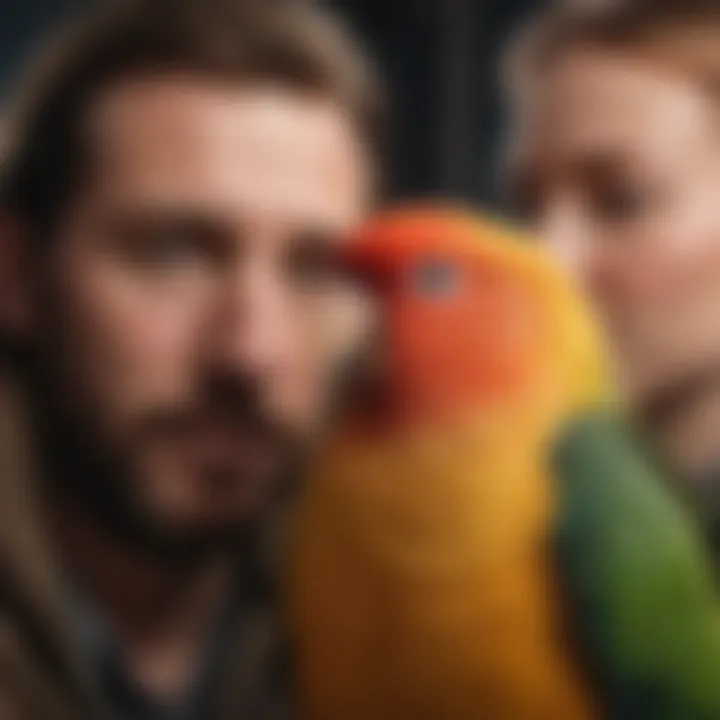
"Lovebirds communicate in ways that may surprise you; get to know their language for a strong bond."
Establishing Bonds with Owners
Creating a bond with a lovebird goes beyond basic care; it involves trust and emotional connection. Lovebirds are known for forming strong attachments to their owners, sometimes even favoring one person above others. This characteristic can be beneficial as it leads to affectionate interactions. When a lovebird feels safe, they display behaviors like cuddling and preening, which are signs of affection.
One unique feature of establishing this bond is the concept of playfulness. Dedicate time to interact with your feathered friend through games or training. A few minutes daily spent just playing can go a long way in solidifying that bond. It’s common for lovebirds to engage in playful antics, which serves to lighten up the atmosphere and draw both owner and bird closer.
Yet, there are challenges too. Some lovebirds may take longer to warm up, requiring consistent effort and understanding from the owner. In that regard, being patient will pay dividends; the more you put in, the more you get out of the relationship. A close bond makes lovebirds not just pets, but cherished members of the family, providing companionship and joy.
Playfulness and Curiosity
Lovebirds are not just bundles of feathers; they are playful, curious creatures that thrive on stimulation. Their innate desire to explore their surroundings and play can lead to delightful interactions and even complicated social dynamics between multiple birds in a household. Encouraging this playfulness is essential as it keeps them mentally engaged and happy.
Their curious nature means they'll investigate every nook and cranny of their cage. This behavior makes it crucial for owners to provide a safe and enriched environment filled with toys and diversions. Simple items like bells, swings, and tunnels can turn an ordinary cage into a wonderland.
Nutritional Needs of Lovebirds
Understanding the nutritional needs of lovebirds is essential for their overall well-being and happiness. These lively avians thrive on a diet balanced in essential nutrients, which ensures that they remain active and healthy. Proper nutrition not only affects their physical health but also their behavioral traits, making it crucial for owners to grasp the significance of feeding their feathered friends rightly.
Balanced Diet Components
Seeds
Seeds form the foundation of a lovebird's diet. They are often the most recognized food, providing a range of essential fats, proteins, and vitamins. One should look for seed mixes that are specifically designed for lovebirds to ensure they receive the proper mix; a luscious blend usually includes canary seed, millet, and sunflower seeds which are relatable to their natural feeding habits.
The key characteristic of seeds is their high energy content, which fuels these birds through their active days. A mixed seed diet can be a beneficial choice, making feeding time exciting and enjoyable for both the owner and the lovebird. However, one can't ignore the unique feature that some seeds are high in fat, which could lead to obesity if not monitored properly. Moderation is the name of the game here.
Fruits
Incorporating fruits into a lovebird's diet can add variety and essential nutrients. These are not just treats; fruits like apples, berries, and melons provide vitamins A and C, as well as antioxidants that boost the immune system.
The key characteristic of fruits lies in their juicy texture and sweetness, making them an appealing addition to the diet. They are a popular choice for many lovebird owners who want to provide something fresh and healthy. One should keep in mind that while fruits are nutritious, they should only make up a small part of the diet. Too much sugar, especially from fruits like bananas and grapes, may upset their stomachs or cause digestive issues.
Vegetables
Vegetables are yet another vital component of a lovebird's diet. Leafy greens like spinach and kale can provide vital nutrients such as calcium and iron. Offering these veggies complements their seed and fruit intake, making their meals balanced and diverse.
The key characteristic of vegetables is that they can be fed either raw or lightly steamed, keeping most of the nutrients intact. It’s a beneficial component as it ensures lovebirds receive crucial vitamins and minerals. However, it’s important to note that not all vegetables are safe; for example, onions and avocados should be strictly avoided as they can be toxic.
Supplementing Diets
Calcium and Mineral Sources
To maintain health, lovebirds need calcium and essential minerals. This is especially true during breeding, where the demand for calcium spikes. Cuttlebone is widely recognized as a great source of calcium, allowing birds to naturally wear down their beaks while munching.
The key characteristic of calcium sources is their role in preventing deficiencies that may lead to health issues such as weak bones or egg binding in females. An adequate supply of calcium can be a beneficial component of their diet, paving the way for stronger, healthier lovebirds. However, owners need to be careful about providing an excess of supplements, as this can also lead to health complications.
Pelleted Diets
Pelleted diets are a convenient option for busy owners looking to ensure their lovebirds receive a complete and balanced diet. These diets are formulated to contain all necessary nutrients in every bite, reducing the fear of imbalanced feeding.
The key characteristic of pelleted diets is their uniformity and convenience; they eliminate the guesswork that often comes with creating a varied diet. For many, they represent a beneficial choice due to their ease of feeding. However, some birds may initially resist switching to pellets, leading to wasted food if they favor seeds or fruits instead.
It's crucial to introduce any dietary changes gradually, allowing the lovebird to adjust to new foods without stressing its system.
Housing Requirements
Creating a cozy home for lovebirds is not just about aesthetics; it’s about ensuring their physical and mental well-being. The housing requirements for these charming birds play a critical role in their happiness and health. An inadequately designed space can lead to stress and undesirable behaviors, while an appropriate environment fosters a sense of security and enhances their social interactions. The essence of properly housing your lovebirds should include considerations of cage types, sizes, and enriching their environment to provide a holistic living space.
Cage Types and Sizes
Lovebirds come in various sizes, and so too do their cages. When selecting a cage, it is vital to choose one that strikes a balance between spaciousness and suitability for your feathered companions. A good rule of thumb for cage dimensions is to aim for a minimum size of 24 x 24 x 36 inches. However, bigger is better in the realm of lovebirds. They thrive in larger homes that give them ample room to spread their wings and explore.
Different types of cages can serve as habitats:
- Wire Cages: These are the most common. They allow for good ventilation and visibility. The spacing between bars should be less than ¾ inch to prevent accidental escapes or injuries.
- Acrylic Cages: Known for modern appearance, these cages keep the mess inside. However, they can lack airflow, so looking for ventilation options is important.
- ** aviaries:** For those looking to provide a more expansive living space, outdoor aviaries can offer fresh air and stimulation from nature. These should be weatherproof and safe from predators.
Whatever type of cage you decide upon, make sure it is easy to clean, as lovebirds can be quite messy.
Environment Enrichment
Perches and Toys
An essential aspect of environment enrichment lies in the creative use of perches and toys. Lovebirds are naturally active and inquisitive, requiring both physical and mental stimulation. Having various perches made from different materials, like wood, rope, and natural branches, offers them exercise and keeps their feet healthy. The ability to climb and move around freely plays a crucial role in their overall comfort.
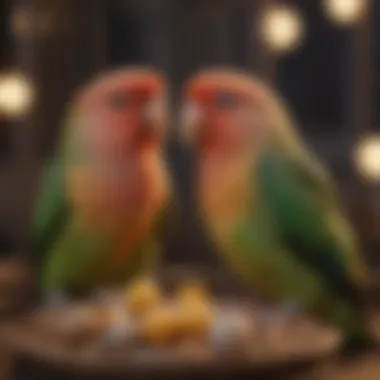
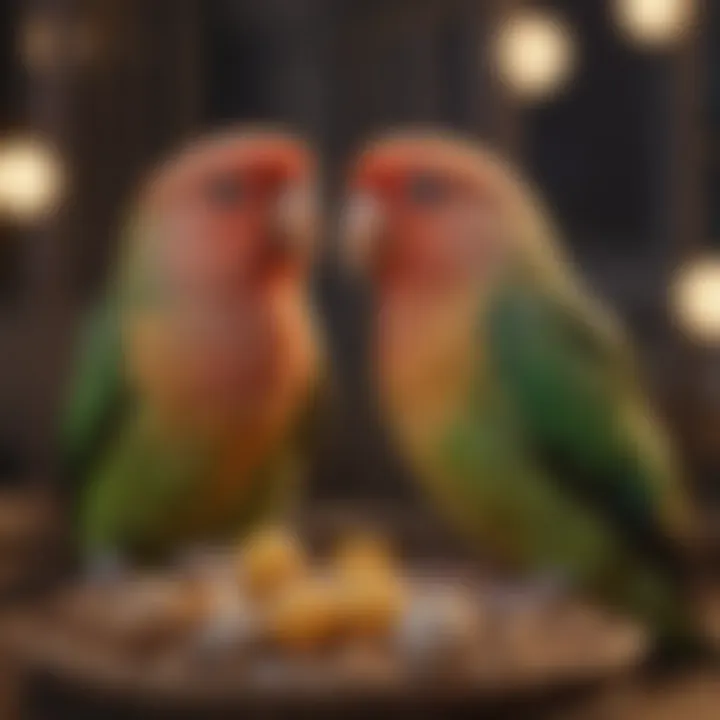
Toys are another fantastic avenue for enhancing their living space. Rotate toys regularly to maintain their interest. Simple options can include:
- Chewable toys: These are excellent for keeping their beaks busy!
- Foraging toys: These stimulate their natural foraging instincts.
- Swinging toys: Perfect for those energetic leaps of joy.
Just as in any lively community, personal choices matter too. Some lovebirds gravitate toward a particular type of toy, and understanding these preferences helps build a tailored environment.
Space for Exercise
The importance of providing adequate space for exercise cannot be emphasized enough. Lovebirds are incredibly active creatures, and limiting space can lead to behavioral issues and health problems, such as obesity. To facilitate exercise, their cage should be large enough to allow for wing-flapping and short flights. Having a safe area for them to explore outside of their cage is also beneficial.
Unique features to consider include:
- Play areas outside the cage: Designate a safe spot where they can hop around freely under supervision.
- Climbing structures: These can be as simple or as elaborate as you like, depending on your living space.
- Interactive activities: Allowing them to engage with their environment provides mental stimulation and physical exercise, leading to happier, healthier birds.
Health Considerations
Understanding the health of lovebirds is critical for anyone considering these charming creatures as pets. Like all animals, lovebirds are susceptible to various health issues that can affect their well-being and lifespan. Prioritizing their health ensures that they thrive in a home environment and fosters a rewarding relationship between owners and their feathered friends. By recognizing potential health concerns early and committing to preventive care, owners can cultivate a happier and healthier pet, ultimately enriching the shared lives of both birds and their keepers.
Common Health Issues
When it comes to keeping lovebirds, awareness of common health issues is a must. Issues like respiratory problems and feather plucking are particularly pivotal. Both can have significant implications for the bird's quality of life.
Respiratory Problems
Lovebirds, like many birds, are prone to respiratory issues, which can stem from a variety of environmental factors. Poor air quality, exposure to cigarette smoke, or dusty environments can lead to tracheal and lung infections. The ability to identify and address respiratory problems early on is crucial for the health of lovebirds.
- Key Characteristic: Lovebirds often show signs of respiratory distress through symptoms like wheezing, sneezing, and lethargy.
- Importance: Addressing these through proper ventilation and avoiding airborne toxins is essential.
- Unique Feature: The keen awareness of a bird's breathing pattern can help detect abnormalities before they escalate into serious conditions.
By being vigilant, owners can prevent respiratory problems from becoming a nuisance in the home.
Feather Plucking
Feather plucking is a behavior that can denote stress or boredom among lovebirds. This compulsive action can lead to significant skin damage and discomfort. Understanding the reasons behind this behavior is essential.
- Key Characteristic: Lovebirds might pluck their feathers due to anxiety, loneliness, or lack of stimulation.
- Importance: Recognizing the triggers for this behavior can lead to devising solutions that reduce stress, thus promoting feather health.
- Unique Feature: Addressing environmental factors and increasing interaction can alleviate the urge to pluck.
By monitoring for feather plucking, owners can make adjustments that support a stable and supportive environment for their lovebirds.
Preventive Care
The best defense against illness is a good offense. Preventive care includes routine vet check-ups and being alert to signs of potential health problems.
Regular Vet Check-Ups
Having regular veterinary check-ups not only helps in catching issues early but fosters an ongoing relationship with a bird care professional. This can be invaluable for understanding the specific needs of your lovebird.
- Key Characteristic: Routine check-ups typically cover everything from weight assessments to overall behavior evaluations.
- Importance: Early detection of health concerns can save your bird's life, and helps you stay informed about best care practices.
- Unique Feature: By addressing health concerns early, you can also improve your lovebird's quality of life.
Maintaining proactive health care routines is a demonstration of responsible ownership.
Signs of Illness
Being observant about your lovebird's behavior can lead to spotting signs of illness before they become critical. Birds, including lovebirds, often do not show outward symptoms of illness until it has progressed significantly. This makes vigilance essential.
- Key Characteristic: Changes in eating habits, vocalizations, and activity levels can all signal something may be amiss.
- Importance: Recognizing these signs can lead to timely medical intervention, which can be the difference between recovery and worsening health.
- Unique Feature: Observing your lovebird's routine allows for easier identification of any deviations from normal behavior.
In essence, staying attentive to signs of illness is not just beneficial but necessary for the happiness and longevity of your lovebird.
In the world of pet care, an ounce of prevention is worth a pound of cure, particularly for lovebirds.
Integrating Lovebirds into the Household
Integrating lovebirds into a household is not just about finding a cozy corner for their cage. It's a multifaceted process that influences their well-being and enrichment, as well as the dynamics between them and their human companions. Understanding how to successfully merge lovebirds into everyday living is crucial for both the birds and their owners. It ensures a tranquil coexistence that benefits all inhabitants—two-legged and four.
Choosing the Right Companions
Other Birds
When it comes to introducing lovebirds to other feathered friends, it is essential to consider their social nature. Lovebirds thrive on companionship and generally do well with other birds, although not every bird species is suitable. Lovebirds display a distinct characteristic of strong pair bonds, which are often formed with their own species.
One key aspect to remember is that while mixing lovebirds with other parrot species may work, it can lead to territorial disputes or stress. For instance, pairing a lovebird with a budgerigar might seem like a fun idea, but it can lead to compatibility issues due to their differing social hierarchies. An advantage of housing lovebirds with other birds is the potential for socialization, which can lead to happier, more active pets. However, owners need to be vigilant in observing interactions to prevent aggressive behavior.
Family Pets
In the case of integrating lovebirds with family pets like cats or dogs, unique considerations come into play. While dogs might be trainable, and some grow accustomed to the presence of birds, cats are inherently predatory, making such a combination potentially dangerous. Nevertheless, some families have successfully raised lovebirds alongside dogs who are gentle and non-threatening. The key here is supervision and a manageable distance initially.
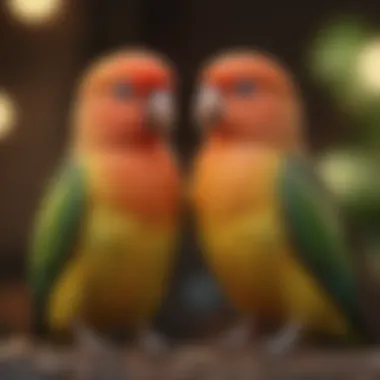
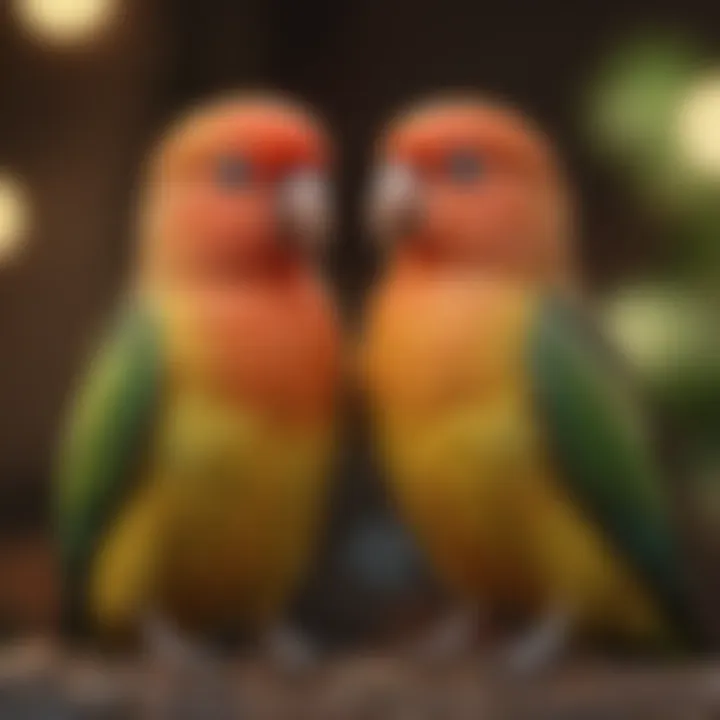
A unique feature of this kinship between lovebirds and family pets is the considerably low-maintenance aspect; since lovebirds are social creatures, they might keep each other entertained during the day. In contrast, the downside is the risk of stress for the birds, as sudden movements or loud noises from dogs or cats could instigate anxiety. Understanding these dynamics is pivotal.
Safety Precautions
When bringing lovebirds into your home, ensuring their safety is paramount. Here are several considerations to reflect on:
- Consider the Environment: Keep the living area free from hazards. Make sure toxic houseplants are out of reach, and keep electrical cords and small objects that could be consumed away from their space.
- Supervision is Key: Always supervise interactions between lovebirds and other pets, especially during those initial introductions.
- Cage Security: Invest in a secure cage that prevents escapes and protects them from potential harm, whether from your other pets or environmental dangers.
Adopting these practices allows lovebirds not only to thrive in their new environment but also to establish meaningful connections with their human family and companions alike.
Enhancing Owner-Bird Interaction
Fostering a strong bond with your lovebird is not just a matter of keeping them fed and housed. Interaction plays a central role in how these vibrant creatures thrive as companions. Understanding how to enhance the owner-bird interaction offers numerous benefits. A well-engaged lovebird is often more social, healthier, and displays less stress. Furthermore, strong ties between the owner and bird lead to a more joyful household, creating an enriching environment for both parties.
Training Techniques
Training your lovebird may sound more daunting than it actually is. The key is to transform learning into a fun and interactive experience. Lovebirds are intelligent little creatures, eager to learn new tricks and commands. Here are some effective techniques for training.
- Positive Reinforcement: This method relies on rewarding your lovebird with treats or praise when they follow a command. It encourages them to repeat the desired behavior. For example, if your lovebird steps onto your finger, offer a small treat right away. It might take some time, but they often catch on quickly.
- Short Sessions: Lovebirds have a short attention span, so keep training sessions brief. Aim for around 5 to 10 minutes, ensuring they remain engaged without becoming bored.
- Use of Clickers: Some owners find clicker training to be quite effective. The click sound acts as a marker that signals to the bird that they have done something right. Pair the click sound with a treat to solidify the connection.
- Patience is Key: Like with any training, patience is a must. Don't forget that lovebirds may not get it all on the first few tries. If you find your feathered friend isn’t responding, take a step back and try again later.
Understanding Body Language
Just like any relationship, understanding each other's senses is vital. Lovebirds communicate through body language, and being able to read these signals will deepen your bond.
- Feather Fluffing: When a lovebird fluffs up its feathers, it may signify they are relaxed and comfortable. This is a good sign that your bird feels safe in its surroundings.
- Head Bobbing: If your lovebird is bobbing its head, it’s often an indication they're excited or trying to get your attention. It's their way of ‘talking back’ to you, so be sure to respond!
- Biting: If your lovebird bites, it’s not always a sign of aggression. They might just be testing boundaries or feeling over-stimulated. Pay attention to context and try to determine if they need more space or if they're feeling threatened.
- Tail Position: A tail held up indicates a happy and alert bird. Conversely, a drooping tail may signal fatigue or illness, which requires your immediate attention.
Remember: Building interaction is a journey, not a sprint. Closely observing and responding to your lovebird's behavior fosters a deeper understanding, enriching both your lives together.
In summary, enhancing the connection between you and your lovebird is not just advantageous; it is essential for a well-balanced pet bird experience. Through training and understanding body language, you can create a harmonious environment that nurtures the bond you share.
Lovebirds Compared to Other Popular Pet Birds
In the realm of pet birds, lovebirds hold a unique charm that captivates many avian enthusiasts. Understanding how they measure up against other popular species, like cockatiels and parakeets, is crucial for prospective bird owners. This knowledge can influence decisions when it comes to selection, care, and interaction.
Lovebirds are often appreciated for their vibrant colors and lively personalities, but it's essential to consider what truly sets them apart. Each bird species has its own unique qualities, strengths, and challenges. A careful assessment of these can help aspiring bird parents select the right feathered companion for their lifestyle and preferences.
Cockatiels vs. Lovebirds
When we look at cockatiels, the contrast with lovebirds begins to take shape. Cockatiels tend to be a bit more mellow; they usually have a calm demeanor. Their whistles and tunes can be charming. However, lovebirds possess a more exuberant personality. They are social butterflies, known to engage in playful antics and foster deep bonds with their humans.
Here are some key differences to ponder:
- Social Interaction: Lovebirds thrive on interaction. They are incredibly social, often needing a partner, be it human or another lovebird, to keep their spirits high. Cockatiels can be very social too, but they may also enjoy their alone time.
- Training and Communication: Cockatiels can be easier to train and are known for their ability to learn whistles and phrases. Lovebirds, while intelligent, often communicate in their own unique, complex signals, which may require some time to decode.
- Cage Space: Both types of birds need adequate space. However, lovebirds need a spacious cage to move and play freely, as they are quite active. Cockatiels will also flourish in larger spaces, but they might not mind a slightly smaller setup.
In short, if you're considering a cockatiel, you might find a gentler pet that hums along to simple tunes. In contrast, a lovebird will dazzle you with boundless energy and affection.
Parakeets vs. Lovebirds
Parakeets, or budgerigars, are another popular choice, often seen as a more manageable option for first-time bird owners. Like lovebirds, parakeets come in vibrant colors, but their behaviors and needs can differ significantly.
Here’s how lovebirds and parakeets compare:
- Activity Level: Lovebirds are known for their high energy. They enjoy climbing, swinging, and playing. Parakeets share this zest for life, but they often exhibit times of calmness, making them a bit easier for some owners to handle.
- Social Dynamics: Parakeets can be social and enjoy the company, but they might be more independent than lovebirds. Lovebirds, on the other hand, often form strong bonds and require consistent interaction.
- Sound Levels: Lovebirds are known to be vocal, often expressing themselves loudly and frequently. Parakeets can be just as chatty, but their range of sounds tends to be less raucous.
Ultimately, selecting between a parakeet and a lovebird can come down to what kind of relationship an owner desires. If you want a lively companion who dances through life with you, a lovebird fits the bill. However, if you prefer a companion that balances playfulness with independence, then parakeets might be your match.
"Choosing the right bird is not just about looks; it’s about understanding their spirit and how it fits into your daily life."
Closure: Commitment to Lovebird Care
Caring for lovebirds goes beyond simply offering seeds and water; it's a long-term commitment that impacts both the bird's lifestyle and its relationship with you. When considering lovebirds as pets, prospective owners must grasp the responsibilities involved. These vibrant creatures thrive on companionship and interaction, and neglect can lead to behavioral issues and health complications. Owners need to invest time and energy into nurturing their feathered friends. Thus, understanding the commitment required ensures a fulfilling experience for both bird and owner.
Long-Term Responsibilities
Owning lovebirds is akin to stepping into a long-term partnership. They aren't just pets; they are accessible companions that require frequent attention and engagement. Key factors include:
- Daily Socialization: Lovebirds are sociable creatures. Daily interaction is vital as it reinforces bonds and provides mental stimulation. Ignoring their needs can lead to loneliness, which can manifest itself in destructive behavior.
- Routine Checks: Regular health assessments—keeping an eye on their eating habits, movement, and droppings—can catch potential health issues early. Always find a qualified avian vet; they know the unique quirks of these birds.
- Consistent Environment: Lovebirds are sensitive to sudden changes in their surroundings. Maintaining a stable environment reduces stress, making them happier. Small shifts in temperature or habitat can lead to anxieties, impacting their overall well-being.
By committing to these long-term responsibilities, owners not only guarantee a healthier and happier life for their lovebirds but also enrich their own lives with companionship.
Fostering a Loving Environment
Creating a nurturing space for lovebirds is essential for their emotional and physical health. This not only reaps benefits for the bird but cultivates a stronger bond between the bird and its owner. Considerations for fostering such an environment include:
- Proper Cage Setup: The type and size of the cage are crucial. Choose spacious cages that allow for easy movement, along with various perches at different heights. This encourages activity and reduces boredom.
- Toys and Enrichment: Lovebirds are naturally curious and playful. Providing stimulating toys that encourage exploration and problem-solving enhances their day-to-day life, preventing behavioral issues.
- Social Interaction: Interacting with lovebirds is key to their happiness. Speaking to them, allowing them out of the cage for play, and engaging in gentle training can help establish trust and companionship. This socialization can become a meaningful routine that benefits both parties.
"A caring environment fosters a connection that ensures lovebird's happiness and strengthens the owner-bird bond."
Fostering a loving environment is not just an obligation; it is an opportunity to forge a deep and meaningful relationship with these charming creatures. The more invested you are, the more rewarding the experience will be.
Navigating the path of lovebird ownership requires patience, understanding, and dedication. Ultimately, the success of this companionship rests on your unwavering commitment to care and nurture your lovebird.















